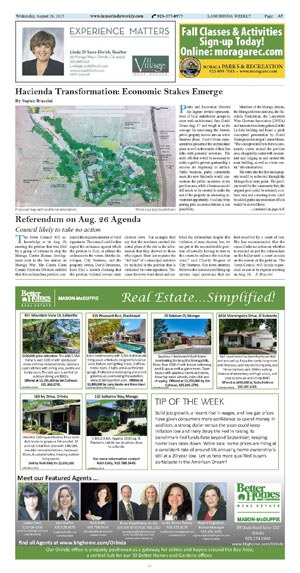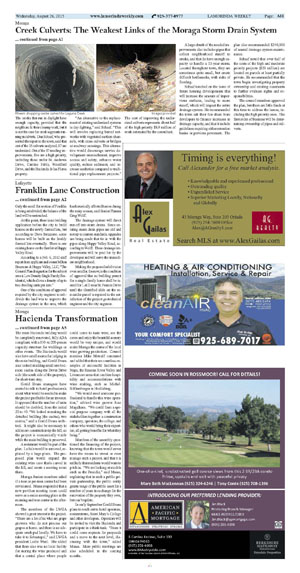|
|
Published August 26th, 2015
|
Hacienda Transformation: Economic Stakes Emerge
|
|
| By Sophie Braccini |
|
|
Parks and Recreation Director Jay Ingram invited representatives of local stakeholder groups to meet with architectural firm Gould Evans Aug. 17 and weigh in as the concept for renovating the historic public property moves into an active business phase. Gould Evans representatives presented the architectural plans as well as the results of their first talks with potential investors. The trade-offs that would be necessary to make a public-private partnership a success are beginning to surface. Partly business, partly community asset, the new Hacienda would concentrate the public amenities in the pavilion area, while a business model still needs to be created to make the rest of the property an interesting investment opportunity. Food and wine pairing plus accommodations is one possibility.
 Members of the Moraga Juniors, the Moraga Movers (seniors), the Hacienda Foundation, the Lamorinda Wine Growers Association (LWGA) and interested residents gathered at the La Sala building and heard a quick conceptual presentation by Gould Evans project manager Lauren Maass. "The concept would be to have a community center around the pavilion area, a hospitality center with a restaurant and lodging in and around the main building, as well as a wine center," she summarized.
Members of the Moraga Juniors, the Moraga Movers (seniors), the Hacienda Foundation, the Lamorinda Wine Growers Association (LWGA) and interested residents gathered at the La Sala building and heard a quick conceptual presentation by Gould Evans project manager Lauren Maass. "The concept would be to have a community center around the pavilion area, a hospitality center with a restaurant and lodging in and around the main building, as well as a wine center," she summarized.
 The entry into the Hacienda property would be redirected through the Moraga Road entry point. The pavilion would be the community hub, the original pool could be restored, a cabana area and a meeting room could be added; parks and recreation offices would be moved there. The main Hacienda building would be completely renovated, fully ADA compliant, with a 150- to 200-person capacity structure for weddings or other events. The Hacienda would also have small rooms for lodging in the main building, and Gould Evans also looked at adding small one-bedroom casitas along the Devin Drive side (the south side of the property), for short-term stay.
The entry into the Hacienda property would be redirected through the Moraga Road entry point. The pavilion would be the community hub, the original pool could be restored, a cabana area and a meeting room could be added; parks and recreation offices would be moved there. The main Hacienda building would be completely renovated, fully ADA compliant, with a 150- to 200-person capacity structure for weddings or other events. The Hacienda would also have small rooms for lodging in the main building, and Gould Evans also looked at adding small one-bedroom casitas along the Devin Drive side (the south side of the property), for short-term stay.
 Gould Evans managers have started to talk to hotel professionals about what would be needed to make the project profitable for an investor. It appeared that the number of units should be doubled, from the initial 20 to 40. "We looked at making the detached building (the casitas), two stories," said a Gould Evans architect. It might also be necessary to add more construction up the hill, so the project is economically viable while the main building is preserved.
Gould Evans managers have started to talk to hotel professionals about what would be needed to make the project profitable for an investor. It appeared that the number of units should be doubled, from the initial 20 to 40. "We looked at making the detached building (the casitas), two stories," said a Gould Evans architect. It might also be necessary to add more construction up the hill, so the project is economically viable while the main building is preserved.
 A restaurant would be part of the plan. La Sala would be removed, replaced by a large plaza. The proposed plan would expand the existing wine cave that's carved in the hill, and create a meeting room there.
A restaurant would be part of the plan. La Sala would be removed, replaced by a large plaza. The proposed plan would expand the existing wine cave that's carved in the hill, and create a meeting room there.
 Moraga Juniors members asked if a teen or pre-teen center had been envisioned. Maass responded that a new pavilion meeting room could serve as a senior meeting place in the morning and teen center in the afternoon.
Moraga Juniors members asked if a teen or pre-teen center had been envisioned. Maass responded that a new pavilion meeting room could serve as a senior meeting place in the morning and teen center in the afternoon.
 The members of the LWGA showed a great interest in the project. "There are a lot of us who are grape growers who do not process our grapes at home, and there is no adequate crush pad locally. We have to take it to Sebastopol," said LWGA president Leslie Ward. She added that there also was no local facility for storing the wine produced and that a central place where people could come to taste wine, see the caves and enjoy the beautiful scenery would be very unique, and would make Moraga the center of the local wine growing production. Council member Mike Metcalf concurred and added that their are countless examples of successful facilities in Napa, the Russian River Valley and Livermore areas that combine hospitality and accommodations with wine making, such as Michel-Schlumberger in Healdsburg.
The members of the LWGA showed a great interest in the project. "There are a lot of us who are grape growers who do not process our grapes at home, and there is no adequate crush pad locally. We have to take it to Sebastopol," said LWGA president Leslie Ward. She added that there also was no local facility for storing the wine produced and that a central place where people could come to taste wine, see the caves and enjoy the beautiful scenery would be very unique, and would make Moraga the center of the local wine growing production. Council member Mike Metcalf concurred and added that their are countless examples of successful facilities in Napa, the Russian River Valley and Livermore areas that combine hospitality and accommodations with wine making, such as Michel-Schlumberger in Healdsburg.
 "We would need someone professional to handle this wine operation," advised wine grower Joao Magalhaes. "We could form a special purpose company with all the stakeholders together: a construction company, operators, the college, and others who would bring their expertise, all getting benefits for what they bring."
"We would need someone professional to handle this wine operation," advised wine grower Joao Magalhaes. "We could form a special purpose company with all the stakeholders together: a construction company, operators, the college, and others who would bring their expertise, all getting benefits for what they bring."
 Members of the assembly questioned the financing of the project, knowing that the town would never have the means to invest or even manage such a project, and that it is unlikely that residents would want to pitch in. "We are looking at models such as the Presidio," said Maass, explaining that in such a public-private partnership, the public entity grants usage of the public asset for a number of years in exchange for the renovation of the property they own, but can't update.
Members of the assembly questioned the financing of the project, knowing that the town would never have the means to invest or even manage such a project, and that it is unlikely that residents would want to pitch in. "We are looking at models such as the Presidio," said Maass, explaining that in such a public-private partnership, the public entity grants usage of the public asset for a number of years in exchange for the renovation of the property they own, but can't update.
 In early September Gould Evans plans to reach out to hotel operators, restaurateurs, Saint Mary's College and other developers. Operators will be invited to visit the Hacienda and participate in a think-tank. "From it could come requests for proposals and a move to the next level, discussing with the town," added Maass. More public meetings are also scheduled in the coming months.
In early September Gould Evans plans to reach out to hotel operators, restaurateurs, Saint Mary's College and other developers. Operators will be invited to visit the Hacienda and participate in a think-tank. "From it could come requests for proposals and a move to the next level, discussing with the town," added Maass. More public meetings are also scheduled in the coming months.

|
|
|
|
|
|
|
|
|
| |
|
|
|
|



